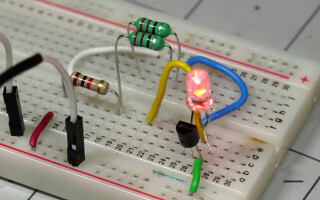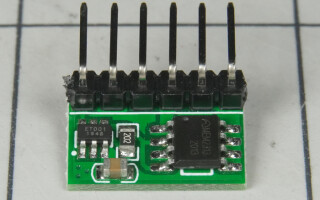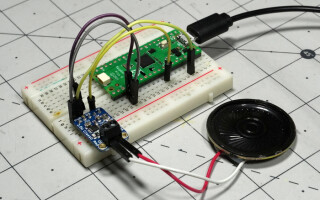Debug & Test
Raspberry Pi Pico Capacitive Foot Pedal Interface - Blog
April 21, 2023If you’ve followed my work for any length of time, you may have noticed that I’m constantly pursuing the “perfect” computer interface. This has resulted in my cycling through a number of input devices, and even developing my fully custom JC Pro Macro 2 keypad. However, I really only have two out of four appendages well-optimized, and in this interface quest I also tried using a foot pedal, as discussed here.
Through Hole and Surface Mount Combination PCB Pads - Blog
April 18, 2023Should you use through hole technology (THT) or surface mount devices (SMD) for your next design? While SMD opens a whole new world of miniature components and machine assembly, if you’re designing something for others to solder in kit form, THT can be more accessible.
Joule Thief ZEEWEII DSO1511G Scope Analysis - Blog
April 07, 2023In the GreatScott! video seen in my last Joule Thief post, he notes that this circuit is difficult to understand. While a full understanding may indeed still elude me, here I’ll use the $60 ZEEWEII DSO1511G scope and signal generator to get a hands-on view of each of my Thief setups.
PCB Coin Cell Battery Holder (and Switch) - Blog
April 06, 2023Recently I’ve been experimenting with coin cell batteries and thought it would be fun to make a light-up pick using one with an LED. Two months later, and I have an LED light PCB that holds a CR2016 or CR2032 battery with no extra components, and which can be assembled without solder.
Useful 3D Prints 2023 - Blog
April 04, 2023When we last left my 3D-printing adventures in late 2021, I had printed a holder for a Ryobi cordless drill, assembly jigs for my macro pad, and piping adapters for laser fume extraction. Since then, I’ve designed and/or printed a wide range of new items, and this article outlines a few of my favorite useful 3D-prints for 2023.
Make a Joule Thief: Three Inductor Options - Blog
March 24, 2023Recently I’ve been considering how to run an LED for a really, really long time on a CR02032 battery, and eventually (re)stumbled upon the idea of a joule thief. The video below does a good job outlining how this circuit works.
Debug & Test
The Well Rounded Engineer - Blog
February 22, 2023Engineering, by its very nature, is a technical pursuit, involving numbers, the translation of science into practical applications, and a lot of tinkering to get things just right. Pursuits such as sports, art, music, writing, and other such “squishy” subjects are fine, but could be considered secondary in nature.
Raspberry Pi Pico CircuitPython MIDI Interface - Blog
February 13, 2023In this article, I’ll first outline the basics of using MIDI with CircuitPython on the Pico for direct interface with a computer. I’ll then show how a Pi 4 (or 3/2) can be used as a host to pipe signals to a keyboard or other device.
Band-Pass Filter Fundamentals With Dual OWON HDS2xx Scopes - Blog
February 06, 2023As a consequence of my review of the OWON HDS2102S oscilloscope/signal generator, and the more recent OWON HDS242 article, I have a signal generator and scope temporarily available. What better time to explore filtering options, namely the band-pass filter!
Raspberry Pi Pico Turns Itself Off for Power Savings - Blog
January 24, 2023While some microcontrollers use a tiny amount of power in shutdown mode–and even while running in some cases–e.g. the ATtiny series–others are more demanding. This can be especially true for dev boards with their additional overhead, and/or if you’re using sensors that never quite turn off power-wise.
I2S Volume Control With Raspberry Pi Pico and CircuitPython - Blog
January 05, 2023In a recent article, I outlined how to play MP3 files on the Raspberry Pi Pico with no extra components, just a small speaker. I also talked about doing this with the addition of an amplifier. While either is fine for many applications, the Pico does not have a true ADC, meaning it instead uses less-than-perfect PWM to simulate an analog output. For better audio quality and output level control, you can instead use digital I2S signaling.
Simple MP3 Audio Playback With Raspberry Pi Pico - Blog
December 12, 2022The RP2040, with a processing speed of 133 MHz, is capable of decoding MP3 files, and the Pico RP2040 dev board includes 2 MB of Flash–enough to store a significant amount of compressed audio. At a list price of $4, the Pico therefore makes an incredible and cost-effective platform for embedded audio playback.
SolveSpace: Light Weight Open Source 3D CAD - Blog
December 01, 2022Recently I happened upon a 3D CAD package1 called SolveSpace. While not the only free and/or freemium package on the market, something about its dark, simplistic interface seemed intriguing. A quick download and install on my Mac OS machine, and I had it running. It boots up in around a second, and it takes up less than 30MB installed, both big positives in my book.
KiCad 6 Align, Distribute, and Array Functions for Massive Time Savings - Blog
November 16, 2022Placing components in the KiCad 6 PCB editor is fairly easy in a broad sense. If you have your grid set correctly, and enough space, getting things roughly in place and connected is fairly trivial. However, what if you need to place a number of footprints in a line, or need to make a grid of vias? Placing each one individually can be tedious, so for these tasks use the align, distribute, and array commands to save a massive amount of time and frustration!
OWON HDS2102S: ~$250 Handheld Scope Review - Blog
November 02, 2022Depending on your level of electronics knowledge, work, and/or experimentation, a voltmeter may be sufficient for your diagnostic needs. However, being able to see the way an electronic signal changes over time, or perhaps even multiple signals, takes your analysis capabilities to a whole new level.
Arduino IDE: 2.0 First Look - Blog
October 13, 2022This September (2022), Arduino announced that its much anticipated 2.0 IDE has been moved to stable and is available for download. New features include the ability to use the serial monitor and plotter simultaneously, quicker compilation, auto-complete, and a number of other enhancements that make it a huge improvement overall.
















